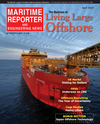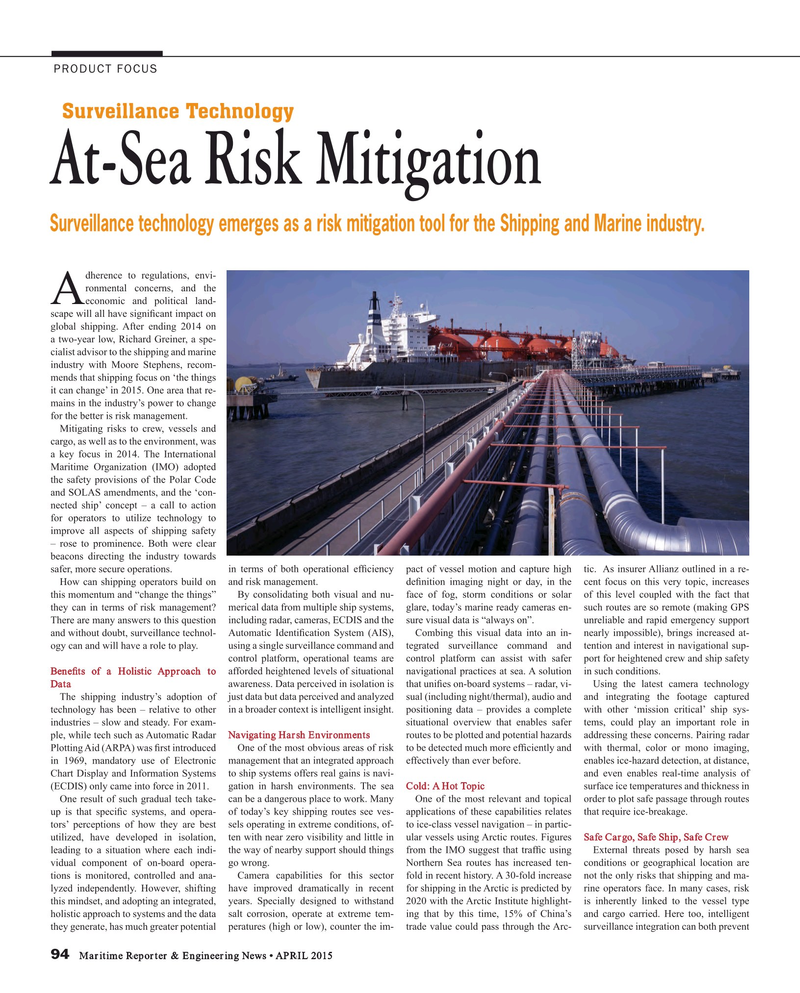
Page 94: of Maritime Reporter Magazine (April 2015)
Offshore Edition
Read this page in Pdf, Flash or Html5 edition of April 2015 Maritime Reporter Magazine
PRODUCT FOCUS
Surveillance Technology
At-Sea Risk Mitigation
Surveillance technology emerges as a risk mitigation tool for the Shipping and Marine industry.
dherence to regulations, envi- ronmental concerns, and the
Aeconomic and political land- scape will all have signi? cant impact on global shipping. After ending 2014 on a two-year low, Richard Greiner, a spe- cialist advisor to the shipping and marine industry with Moore Stephens, recom- mends that shipping focus on ‘the things it can change’ in 2015. One area that re- mains in the industry’s power to change for the better is risk management.
Mitigating risks to crew, vessels and cargo, as well as to the environment, was a key focus in 2014. The International
Maritime Organization (IMO) adopted the safety provisions of the Polar Code and SOLAS amendments, and the ‘con- nected ship’ concept – a call to action for operators to utilize technology to improve all aspects of shipping safety – rose to prominence. Both were clear beacons directing the industry towards safer, more secure operations. in terms of both operational ef? ciency pact of vessel motion and capture high tic. As insurer Allianz outlined in a re-
How can shipping operators build on and risk management. de? nition imaging night or day, in the cent focus on this very topic, increases this momentum and “change the things” By consolidating both visual and nu- face of fog, storm conditions or solar of this level coupled with the fact that they can in terms of risk management? merical data from multiple ship systems, glare, today’s marine ready cameras en- such routes are so remote (making GPS
There are many answers to this question including radar, cameras, ECDIS and the sure visual data is “always on”. unreliable and rapid emergency support and without doubt, surveillance technol- Automatic Identi? cation System (AIS), Combing this visual data into an in- nearly impossible), brings increased at- ogy can and will have a role to play. using a single surveillance command and tegrated surveillance command and tention and interest in navigational sup- control platform, operational teams are control platform can assist with safer port for heightened crew and ship safety
Bene? ts of a Holistic Approach to afforded heightened levels of situational navigational practices at sea. A solution in such conditions.
Data awareness. Data perceived in isolation is that uni? es on-board systems – radar, vi- Using the latest camera technology
The shipping industry’s adoption of just data but data perceived and analyzed sual (including night/thermal), audio and and integrating the footage captured technology has been – relative to other in a broader context is intelligent insight. positioning data – provides a complete with other ‘mission critical’ ship sys- industries – slow and steady. For exam- situational overview that enables safer tems, could play an important role in ple, while tech such as Automatic Radar Navigating Harsh Environments routes to be plotted and potential hazards addressing these concerns. Pairing radar
Plotting Aid (ARPA) was ? rst introduced One of the most obvious areas of risk to be detected much more ef? ciently and with thermal, color or mono imaging, in 1969, mandatory use of Electronic management that an integrated approach effectively than ever before. enables ice-hazard detection, at distance,
Chart Display and Information Systems to ship systems offers real gains is navi- and even enables real-time analysis of (ECDIS) only came into force in 2011. gation in harsh environments. The sea Cold: A Hot Topic surface ice temperatures and thickness in
One result of such gradual tech take- can be a dangerous place to work. Many One of the most relevant and topical order to plot safe passage through routes up is that speci? c systems, and opera- of today’s key shipping routes see ves- applications of these capabilities relates that require ice-breakage. tors’ perceptions of how they are best sels operating in extreme conditions, of- to ice-class vessel navigation – in partic- utilized, have developed in isolation, ten with near zero visibility and little in ular vessels using Arctic routes. Figures Safe Cargo, Safe Ship, Safe Crew leading to a situation where each indi- the way of nearby support should things from the IMO suggest that traf? c using External threats posed by harsh sea vidual component of on-board opera- go wrong. Northern Sea routes has increased ten- conditions or geographical location are tions is monitored, controlled and ana- Camera capabilities for this sector fold in recent history. A 30-fold increase not the only risks that shipping and ma- lyzed independently. However, shifting have improved dramatically in recent for shipping in the Arctic is predicted by rine operators face. In many cases, risk this mindset, and adopting an integrated, years. Specially designed to withstand 2020 with the Arctic Institute highlight- is inherently linked to the vessel type holistic approach to systems and the data salt corrosion, operate at extreme tem- ing that by this time, 15% of China’s and cargo carried. Here too, intelligent they generate, has much greater potential peratures (high or low), counter the im- trade value could pass through the Arc- surveillance integration can both prevent 94 Maritime Reporter & Engineering News • APRIL 2015
MR #4 (90-97).indd 94 MR #4 (90-97).indd 94 4/2/2015 9:52:36 AM4/2/2015 9:52:36 AM

 93
93

 95
95
